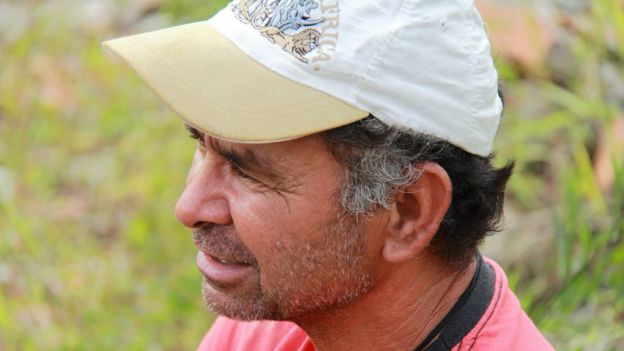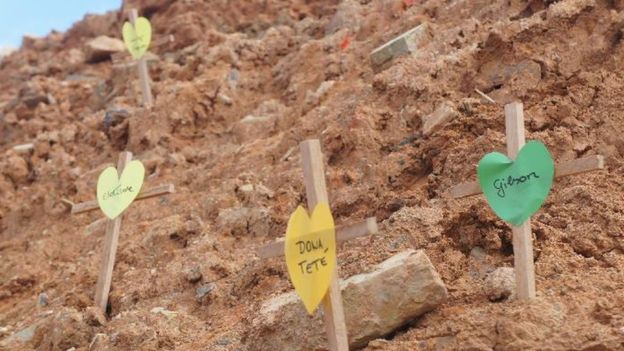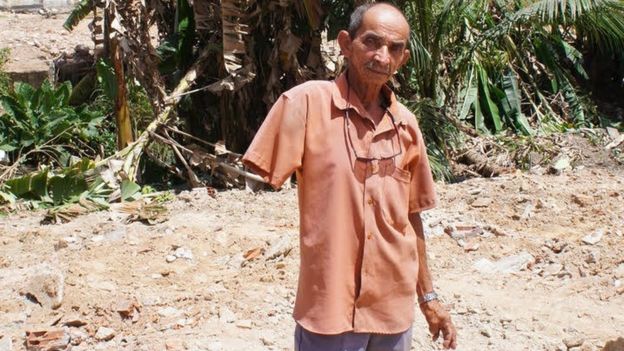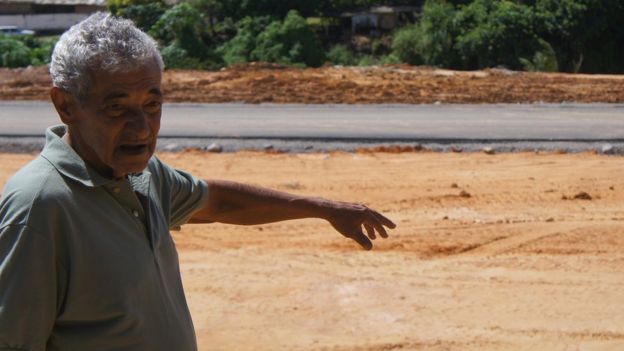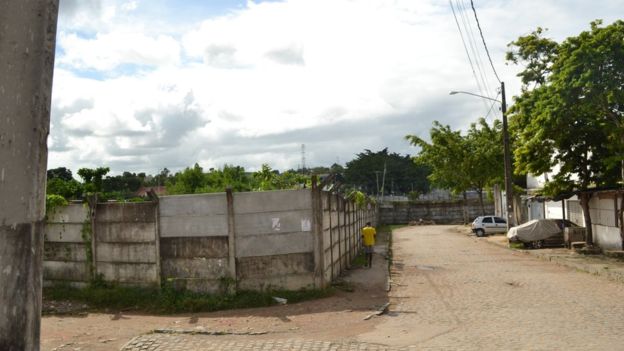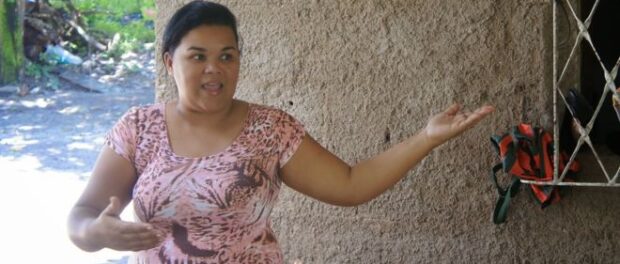
For the original article in Portuguese by Júlia Dias Carneiro published by BBC News Brasil click here.
Romildo Ramos’ land was an “entire ranch”—with fruit trees, drinking water and a house constructed with great effort over the course of many years, situated in Loteamento São Francisco, Camaragibe, in the metropolitan region of Recife. That is, until the 2014 World Cup emerged on the horizon, provoking a series of evictions to make way for the Pernambuco Arena, one of the tournament’s twelve stadiums.
“We had our place, our home. We were happy,” says Paula Santos, 41 years old, Ramos’ daughter-in-law. “Everything was torn down. What was the Cup for? To remove families from their place?”
Mr. Ramos died shortly after the World Cup ended, in late July 2014. His house had been demolished and he was in debt from hastily constructing a one-room dwelling on the piece of land that remained after half of his lot was expropriated. “He was suffocating. He had heart problems and died of a heart attack. He couldn’t handle the stress,” she laments.
Four years after the World Cup, Santos can still only feel disgusted in looking at the stadium near her home. The stadium, which hosted five games during the tournament, was built by Odebrecht at the cost of $532 million reais.
“This stole our dreams, our stability. The possibility for us to live in a safe place. Today we live by the World Cup roadway, with the land exposed to the street, where cars pass right by. There’s no safety, we have no neighbors. It’s total neglect,” she says.
The plight of residents who were evicted during the preparations for the 2014 World Cup [in Recife] was similar across other host cities in Brazil. Thousands of removals took place, not only for stadiums but also to clear space for infrastructure projects for the mega-event, like express highways for BRTs Bus Rapid Transit) and the widening of roads.
In Rio de Janeiro alone, according to calculations from the city’s Popular Committee on the World Cup and Olympics, more than 22,000 families were forcibly removed or had their land seized between 2009 and 2015 for preparations related to the World Cup and the 2016 Rio Olympic Games.
One of those people was Jorge Santos, 57 years old, the last resident to leave Vila Recreio II, a community of over 183 families in Recreio dos Bandeirantes that was evicted to make way for the Transoeste BRT line.
“The Cup has come and gone, the Olympics are over, and 80% of our space just lies there, vacant,” says Santos.
For him, the cost and the effort to host the World Cup made the event “fall from grace” for Brazilians.
“The World Cup happened at the expense and misfortune of a lot of Brazilian people. Thank God Germany beat us 7-1; if Brazil had won, there would have been the argument that it was all worth it. Brazil needed an excuse.”
“The Mania of Grandeur”
According to reports heard by BBC News Brasil, many of the families removed during the preparations for the mega-events continue to experience long-term impacts.
Damages include the insecurity of housing situations; the accumulation of debt; the breakdown of community ties; displacement to peripheral regions, which are sometimes dominated by criminal factions; and complicated and extensive bureaucratic processes to receive compensation.
There is also a huge frustration felt in cases in which expropriated areas ended up not being used for the reasons used to justify the evictions. This was the case for some of the evictions that occurred in Recife, where there had been ambitious plans to build a “World Cup City” in the areas surrounding the Pernambuco Arena, erected in the municipality of São Lourenço da Mata in the metropolitan area of the capital.
“Pernambuco had a real mania of grandeur; the initial project touted a cutting-edge city. It was going to be the first ‘smart city’ in Latin America with the stadium, shopping malls, schools, and universities,” recalls architect and urbanist Ana Ramalho, a professor at Damas University. “None of this was built, just the stadium,” she said.
Ramalho was part of an interdisciplinary research team at the Metropolis Observatory that monitored the impact of the World Cup on the twelve Brazilian host cities, coordinating the center in Recife.
She estimates that 900 families suffered removals in the stadium area, but that number is not official. The architect said that despite repeated requests for information from the state government at the time, official numbers were never released to the research group.
Upon request by BBC News Brasil, the State Attorney General of Pernambuco (PGE-PE) reported that 121 properties were seized and removed around the area of the stadium in the municipality of Camaragibe in order to carry out construction work for World Cup City roadway, including the Camaragibe Integrated Bus Terminal and the construction of the East-West Road Corridor.
Of the six roads originally designed, the World Cup City only ended up with two; and the integrated terminal was never built.
“The area was left untouched, a large vacant lot which is now closed off,” says Ramalho. “Four years later, it hasn’t been made into anything. There is no evidence of public benefit for the forced evictions of so many families in this region,” affirms the architect.
Questioned by BBC News Brasil, the Pernambuco Secretary of Cities affirmed that the area would still be used for the expansion of the Camaragibe Integrated Bus Terminal.
“A new planning bid will be sought to revise the terminal’s expansion project,” the agency says, through its press office.
Deaths “from Grief”
Since her father-in-law died almost four years ago, Paula Santos and her husband spent money that “they didn’t have” to make an inventory [of assets of the deceased] and build a simple house—which remains unfinished—to replace their demolished home. They live with their two sons on the piece of land that has remained in the family’s possession.
They are still awaiting compensation for the expropriated area; their case is currently stuck in court. Mr. Ramos’ widow, Neuza Lucinda, 64 years old, lives in the little room that he built shortly before he died, located on the low-lying part of the land that floods whenever it rains.
Santos says that the conditions are very precarious. “She is depressed, living in a mud hut, a shack that he built. We have told her to come and live with us, but she doesn’t want to. She doesn’t want to leave the house,” she said.
“They took everything we had, and nothing has been done about it. It is total abuse. We were so happy. Now we are entrenched in debt. They seized our home from its place, and that was it,” she says exasperatedly.
Santos counts eleven people from the community who died during the eviction process in Loteamento São Francisco.
In May 2014, shortly before the World Cup, a protest took place in response to the death of the eight elderly people who passed away during the struggle against evictions. After that came the death of Mr. Ramos, right after the World Cup, followed by the death of Jerônimo Sebastião just a few months later.
In May 2014, BBC News Brasil interviewed Mr. Sebastião in Loteamento São Francisco. He was 72 years old and was deeply distressed by the situation. His niece was letting him stay with her. He said that he had received compensation, which was less than half of the value of his home and was insufficient to buy another.
Mr. Sebastião said at the time, “I had built my future; it was my home, which took a lot of effort. And then, suddenly, they came and defeated us like that. They destroyed what was ours without giving us our rights.”
“He had a ranch, which was seized for the World Cup roadway. He ended up living near a garbage dump, in a favela in a very dramatic situation,” recalls researcher Eduardo Amorim, who wrote his Masters dissertation about “the silences and silencing of media coverage during the World Cup in Pernambuco” at the Federal University of Pernambuco (UFPE).
Paula Santos said that he was “desperate” after moving to the favela. “He couldn’t live there. He was frantic, his mind in overdrive, saying he would sell that place to buy somewhere else. He fell into depression and died.”
“I Bought My Property”
Ana Ramalho recalls that Loteamento São Francisco was regularized. People living there had bought their land and had no history of resistance or occupation.
“People were saying that they should protest, close roads, burn tires in the streets. And they said, ‘I don’t do this, I have never done this. I bought my house, why would I now go and burn tires in the streets?”
For the architect, the process involved “blatant” errors in terms of urban planning. “And from a human point of view, it was so sad to see private business interests superseding urban management. It was an incredibly aggressive process.”
According to the State Attorney General of Pernambuco, of the 121 seizures carried out in the locale, 55 were carried out in an administrative manner–meaning that the owners entered an agreement with the State to receive the proposed compensation value–and the payments were already settled. The other 66 went through a judicial process, involving legal issues or price disputes, but the payments were settled in around 90% of cases.
For the rest, compensation is deposited with the courts; the release of funds is contingent upon compliance with legal requirements, including proof of property ownership and regularisation of taxes levied against the seized property.
Unnecessary Removals
In Rio de Janeiro, the pressure exerted from mega-events was two-fold, with works carried out to host both the 2014 World Cup and 2016 Olympic Games.
According to architect and urbanist Giselle Tanaka, a researcher from the Institute of Research in Urban and Regional Planning (IPPUR) at the Federal University of Rio de Janeiro (UFRJ), the highest volume of evictions occurred between 2009 and 2010.
Since then, the process has taken place at more widely spaced intervals, facing greater community mobilization and resistance and condemnation from human rights defense entities.
Tanaka was part of the Popular Committee on the World Cup and Olympics in Rio, which produced periodic reports about the impacts and human rights violations related to the organization of mega-events. She believes that the situation today, in the aftermath of evictions, confirms warnings the group issued in the past.
“The fact that many of the disappropriated areas remain empty to this day, four years later, just confirms that so many of those evictions were not necessary”, she says. “It shows that the removals weren’t motivated by the need for public works, but rather by social cleansing. The objective was to get rid of poorer residents from areas that they wanted to appreciate in value.”
Amongst the examples cited by Tanaka were Vila Autódromo, next to the Olympic Park; the favela of Metrô-Mangueira, close to the Maracanã; and Vila Recreio I and II, where evictions gave way to a large hedge planted alongside Avenida das Américas.
When questioned, City authorities did not respond prior to the publication of this report, stating that since it is a matter of the prior administration, they’d need more time to gather information on plans for the lands.
The gardener Jorge Santos, 57 years old, recalls the pressure placed on Recreio II, where he lived with his family for sixteen years. He said that it began in 2007, during the Pan-American Games in Rio.
In anticipation of the World Cup, the community gained support from human rights organizations like Amnesty International, seeking to show that the evictions were not necessary for the BRT route. Unfortunately, they didn’t manage to stop the eviction proceedings.
“They knocked my house down while everything I owned was still inside—and this was while the BRT was already in operation,” recalls Santos.
He received around R$27,000 in compensation for his home and his daughter’s property. The money was spent in a short time, having to pay rent. “I had a house with a living room, kitchen, bathroom, two bedrooms and a balcony—and they gave me an amount worth a wooden shack,” he said.
Neighbors that had agreed to enter into negotiations with the City ended up receiving a lot more, he recalls, with amounts up to R$150,000.
“Since I decided to fight, they gave me a much lower amount. But my fight was not about money. It was to live where I have the right to live—until they proved to me that the use of the space was really necessary. It was never proven to be necessary.”
The majority of families from Vila Recreio II opted to negotiate compensation with the City, but some agreed to be resettled in Minha Casa Minha Vida (MCMV) public housing in Campo Grande, in the West Zone of Rio. However, many ended up not being able to stay there—a place dominated by militia groups.
Today, Santos lives in Vila Taboinha, a favela approximately one kilometer away from Vila Recreio II. By selling his van, he managed to buy some land, and bit by bit, he is building a new house. However, his land tenure situation is irregular and he is frustrated whenever he passes by the area of his old community, the forest covering the remaining debris from the houses.
“Housing is not just about the physical house,” he affirms, “it’s the whole structure of family, friendship, coexistence, work, school for the kids, the religious community. You, who are modern and educated, call it ‘belonging,’ don’t you? It’s an established right, one that has been taken away from us.”

